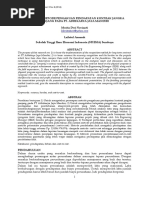Chapter 2 - Searching & Sorting Algorithm
Uploaded by
Getaneh AwokeChapter 2 - Searching & Sorting Algorithm
Uploaded by
Getaneh AwokeDebreMarkos University College of Technology Department of Information Technology
CHAPTER TWO
2. TIME COMPLEXITY OF KNOWN ALGORITHMS
2.1. Searching algorithms
Organizing and retrieving information is at the heart of most computer applications, and
searching is surely the most frequently performed of all computing tasks. Search can be viewed
abstractly as a process to determine if an element with a particular value is a member of a
particular set. The more common view of searching is an attempt to find the record within a
collection of records that has a particular key value or those records in a collection whose key
values meet some criterion such as falling within a range of values.
Searching is a process of looking for a specific element in a list of items or determining that the
item is not in the list. There are two simple searching algorithms:
• Sequential Search, and
• Binary Search
2.1.1. Linear Search (Sequential Search)
The sequential search algorithm begins at the first position in the array and looks at each value in
turn until K is found. Once K is found, the algorithm stops. It steps through the data sequentially
until a match is found.
It compares the key element with each element in the list A[n], and returns the index i if the key
is found, or -1 if the key is not found.
The basic idea is:
Loop through the array starting at the first element until the value of target matches one
of the array elements.
Return the index if match is found, and if a match is not found, return –1.
Implementation example:
int Linear_Search(int list[ ], int key)
{ // n is size of the list
int index=0;
int found=0;
do{
if(key = = list[index])
found=1;
else
index++;
} while(found = = 0 && index < n);
if(found= = 0)
index=-1;
return index;
}
Data Structure and Algorithm (ITec 2051)
1
DebreMarkos University College of Technology Department of Information Technology
There is a wide range of possible running times for the sequential search algorithm. The first
integer in the array could have value K, and so only one integer is examined. In this case the
running time is short. This is the best case for this algorithm, because it is not possible for
sequential search to look at less than one value. Alternatively, if the last position in the array
contains K, then the running time is relatively long, because the algorithm must examine N
values. This is the worst case for this algorithm, because sequential search never looks at more
than N values. If we implement sequential search as a program and run it many times on many
different arrays of size N, or search for many different values of K within the same array, we
expect the algorithm on average to go halfway through the array before finding the value we
seek. On average, the algorithm examines about N/2 values.
The complexity of the algorithm is analyzed in three ways. First, we provide the cost of an
unsuccessful search. Then, we give the worst-case cost of a successful search. Finally, we find
the average cost of a successful search. Analyzing successful and unsuccessful searches
separately is typical. Unsuccessful searches usually are more time consuming than are successful
searches.
An unsuccessful search requires the examination of every item in the array, so the time will be
O(N). In the worst case, a successful search, too, requires the examination of every item in the
array because we might not find a match until the last item. Thus the worst-case running time for
a successful search is also linear. On average, however, we search only half an array. That is, for
every successful search in position i, there is a corresponding successful search in position N-1- i
(assuming we start numbering from 0). However, N/2 is still O(N).
2.1.2. Binary Search
This searching algorithms works only on an ordered list. Suppose you have a sorted array, and
you wish to search it for a particular value, x. The key idea is that since the array is sorted, you
can narrow your focus to a section of the array that must contain x if x is in the array at all. In
particular, x must come before every element greater than x and after every element less than x.
We call the section of the array that could contain x the section of interest. We can iteratively
home in on x with a loop that shrinks the section of interest while maintaining the loop invariant
that x is in that section, if it is in the array at all.
Binary search is performed from the middle of the array rather than the end. We keep track of
low and high, which delimit the portion of the array in which an item, if present, must reside.
Initially, the range is from 0 to N - 1. If low is larger than high, we know that the item is not
present, so we return NOT-FOUND. Otherwise, we let mid be the halfway point of the range
(rounding down if the range has an even number of elements) and compare the item we are
searching for with the item in position mid. If we find a match, we are done and can return. If the
item we are searching for is less than the item in position mid, then it must reside in the range
low to mid-1. If it is greater, then it must reside in the range mid+l to high.
Data Structure and Algorithm (ITec 2051)
2
DebreMarkos University College of Technology Department of Information Technology
The basic idea is:
• Locate midpoint of array to search
• Determine if target is in lower half or upper half of an array.
o If in lower half, make this half the array to search
o If in the upper half, make this half the array to search
• Loop back to step 1 until the size of the array to search is one, and this element does not
match, in which case return –1.
Implementation example:
int Binary_Search(int list[ ], int k)
{ //n is size of the list
int low = 0;
int high = n-1;
int found = 0;
do{
mid = (low + high)/2;
if(key = = list[mid])
found=1;
else{
if(key < list[mid])
high = mid-1;
else
low = mid+1;
}
}while(found = = 0 && low < high);
if(found = = 0)
index = -1;
else
index = mid;
return index;
}
For an unsuccessful search, the number of iterations in the loop is logN + 1. The reason is that
we halve the range in each iteration (rounding down if the range has an odd number of
elements); we add 1 because the final range encompasses zero elements. For a successful search,
the worst case is log N iterations because in the worst case we get down to a range of only one
element. The average case is only one iteration better because half the elements require the worst
case for their search, a quarter of the elements save one iteration, and only one in 2i elements
save i iterations from the worst case. The mathematics involves computing the weighted average
by calculating the sum of a finite series. The end result, however, is that the running time for
each search is O(log N).
Data Structure and Algorithm (ITec 2051)
3
DebreMarkos University College of Technology Department of Information Technology
Initially, the number of candidate entries is n; after the first call to Binary_Search, it is at most
n/2; after the second call, it is at most n/4; and so on. In general, after the ith call to
Binary_Search, the number of candidate entries remaining is at most n/2i. In the worst case
(unsuccessful search), the recursive calls stop when there are no more candidate entries. Hence,
the maximum number of recursive calls performed, is the smallest integer m such that n/2m< 1.
In other words (recalling that we omit a logarithm's base when it is 2), m > log n. Thus, we have
m= log n + 1, which implies that binary search runs in O(log n) time.
As an example, if we have 128 entries, then the remaining candidate entries after each iteration
are 64, 32, 16, 8, 4, 2, 1, 0. Thus, the running time is O(logN).
2.2. Sorting Algorithms
Sorting is one of the most important operations performed by computers. Sorting is a process of
reordering a list of items in either increasing or decreasing order. The following are simple
sorting algorithms used to sort small-sized lists.
• Insertion Sort
• Selection Sort
• Bubble Sort
2.2.1. Insertion Sort
An insertion sort starts by considering the two first elements of the array data, which are data[0]
and data[1]. If they are out of order, an interchange takes place. Then, the third element, data[2],
is considered. If data[2] is less than data[0] and data[1], these two elements are shifted by one
position; data[0] is placed at position 1, data[1] at position 2, and data[2] at position 0. If data[2]
is less than data[1] and not less than data[0], then only data[1] is moved to position 2 and its
place is taken by data[2]. If, finally, data[2] is not less than both its predecessors, it stays in its
current position. Each element data[i] is inserted into its proper location j such that 0 ≤ j ≤ i, and
all elements greater than data[i] are moved by one position.
The insertion sort works just like its name suggests - it inserts each item into its proper place in
the final list. The simplest implementation of this requires two list structures - the source list and
the list into which sorted items are inserted. To save memory, most implementations use an in-
place sort that works by moving the current item past the already sorted items and repeatedly
swapping it with the preceding item until it is in place.
It's the most instinctive type of sorting algorithm. The approach is the same approach that you
use for sorting a set of cards in your hand. While playing cards, you pick up a card, start at the
beginning of your hand and find the place to insert the new card, insert it and move all the others
up one place.
Data Structure and Algorithm (ITec 2051)
4
DebreMarkos University College of Technology Department of Information Technology
The basic idea:
Find the location for an element and move all others up, and insert the element.
The process involved in insertion sort is as follows:
The left most value can be said to be sorted relative to itself. Thus, we don’t need to do anything.
Check to see if the second value is smaller than the first one. If it is, swap these two values. The
first two values are now relatively sorted.
Next, we need to insert the third value in to the relatively sorted portion so that after insertion,
the portion will still be relatively sorted.
Remove the third value first. Slide the second value to make room for insertion. Insert the value
in the appropriate position.
Now the first three are relatively sorted.
Do the same for the remaining items in the list.
Implementation example:
void Insertion_Sort(int list[ ] )
{
int i, j, temp;
for( i = 1; i < n; i++)
{
temp=list[i];
for( j=i; j>0 && temp<list[j-1];j--)
{ // work backwards through the array finding where temp should go
list[j]=list[j-1];
}//end of inner loop
list[j]=temp;
}//end of outer loop
}//end of Insertion_Sort
The following figure shows how the array [5 2 3 8 1] is sorted by insertion sort.
Data Structure and Algorithm (ITec 2051)
5
DebreMarkos University College of Technology Department of Information Technology
Because an array having only one element is already ordered, the algorithm starts sorting from
the second position, position 1. Then for each element temp = data[i], all elements greater than
temp are copied to the next position, and temp is put in its proper place.
To find the number of comparisons performed by insertion sort algorithm, observe first that the
outer for loop always performs n-1 iterations. The best case is when the data are already in order.
Only one comparison is made for each position i, so there are n - 1 comparisons, which is O(n), ,
and 2(n - 1) moves, all of them redundant.
The worst case is when the data are in reverse order. In this case, for each i, the item data[i] is
less than every item data[0], . . . , data[i-1], and each of them is moved by one position. For each
iteration i of the outer for loop, there are i comparisons, and the total number of comparisons for
all iterations of this loop is
𝒏−𝟏 𝒏(𝒏−𝟏)
𝒊=𝟏 (𝒊) = 1 + 2 + 3+ . . . + (n-1) = = O(n2)
𝟐
The number of times the assignment in the inner for loop is executed can be computed using the
same formula. The number of times temp is loaded and unloaded in the outer for loop is added to
that, resulting in the total number of moves
𝒏(𝒏−𝟏) 𝒏𝟐 +𝟑𝒏 − 𝟒
+ 2 (n - 1) = = O(n2)
𝟐 𝟐
2.2.2. Selection Sort
Selection sort is an attempt to localize the exchanges of array elements by finding a misplaced
element first and putting it in its final place. The element with the lowest value is selected and
exchanged with the element in the first position. Then, the smallest value among the remaining
elements data[1], . . . , data[n-1] is found and put in the second position. This selection and
placement by finding, in each pass i, the lowest value among the elements data[i], . . . , data[n-1]
and swapping it with data[i] are continued until all elements are in their proper positions.
The following pseudo code reflects the simplicity of the algorithm:
selectionsort(data[ ] , n)
for i = 0 to n-2
select the smallest element among data[i], . . . , data[n-1];
swap it with data[i];
It is rather obvious that n-2 should be the last value for i, because if all elements but the last have
been already considered and placed in their proper positions, then the nth element (occupying
position n-1) has to be the largest.
Data Structure and Algorithm (ITec 2051)
6
DebreMarkos University College of Technology Department of Information Technology
The basic idea:
Loop through the array from i=0 to n-1.
Select the smallest element in the array from i to n
Swap this value with value at position i.
Implementation example:
void Selection_Sort(int data[ ] )
{
int i,j, least;
for( i = 0; i<n-1; i++ )
{
least = i;
for( j = i+1; j<n; j++ )
{
if(data [j] < data [least])
least = j;
}//end of inner loop
temp = data [least];
data [least] = data [i];
data [i] = temp;
} //end of outer loop
}//end of Selection_Sort
The following figure shows how the array [5 2 3 8 1] is sorted by selection sort.
Note: least in the implementation and figure above is not the smallest element but its position.
The analysis of the performance of the function Selection_Sort ( ) is simplified by the presence
of two for loops with lower and upper bounds. The outer loop executes n - 1 times, and for each i
between 0 and n - 2, the inner loop iterates j = (n -1) - i times. Because comparisons of keys are
done in the inner loop, there are
𝒏−𝟏 𝒏(𝒏−𝟏)
𝒊=𝟏 (𝒏 − 𝟏 − 𝒊) = (n-1) + (n-2) + (n-3) + . . . + 3 + 2 + 1 = = O(n2)
𝟐
Data Structure and Algorithm (ITec 2051)
7
DebreMarkos University College of Technology Department of Information Technology
comparisons. This number stays the same for all cases. There can be some savings only in the
number of swaps. Note that if the assignment in the if statement is executed, only the index jis
moved, not the item located currently at position j. Array elements are swapped unconditionally
in the outer loop as many times as this loop executes, which is n-1 i.e. O(n).
2.2.3. Bubble Sort
A bubble sort can be best understood if the array to be sorted is envisaged as a vertical column
whose smallest elements are at the top and whose largest elements are at the bottom. The array is
scanned from the bottom up, and two adjacent elements are interchanged if they are found to be
out of order with respect to each other. First, items data[n-1] and data[n-2] are compared and
swapped if they are out of order. Next, data[n-2] and data[n-3] are compared, and their order is
changed if necessary, and so on up to data[1] and data[0]. In this way, the smallest element is
bubbled up to the top of the array.
However, this is only the first pass through the array. The array is scanned again comparing
consecutive items and interchanging them when needed, but this time, the last comparison is
done for data[2] and data[1] because the smallest element is already in its proper position,
namely, position 0. The second pass bubbles the second smallest element of the array up to the
second position, position 1. The procedure continues until the last pass when only one
comparison, data[n-1] with data[n-2], and possibly one interchange are performed.
A pseudo code of this algorithm is as follows:
bubblesort(data[ ] , n)
for i = 0 to n - 2
for j = n-1down to i+1
swap elements in positions j and j-1 if they are out of order;
Bubble sort is the simplest algorithm to implement and the slowest algorithm on very large
inputs.
The basic idea of the algorithm is:
Loop through array from i=0 to n and swap adjacent elements if they are out of order.
Data Structure and Algorithm (ITec 2051)
8
DebreMarkos University College of Technology Department of Information Technology
Implementation example:
void Bubble_Sort( data[ ] )
{
int i, j, temp;
for( i = 0; i < n-1; i++)
{
for( j = n-1; j > i; j--)
{
if(data [ j ] < data [ j-1 ] )
{
temp = data [ j ];
data [ j ] = data [ j-1 ];
data [ j-1 ] = temp;
}//swap adjacent elements
}//end of inner loop
}//end of outer loop
}//end of Bubble_Sort
The following figure shows how the array [5 2 3 8 1] is sorted by bubble sort.
The number of comparisons is the same in each case (best, average, and worst) and equals the
total number of iterations of the inner for loop
𝒏−𝟏 𝒏(𝒏−𝟏)
𝒊=𝟏 (𝒏 − 𝟏 − 𝒊) = = O(n2)
𝟐
comparisons. This formula also computes the number of swaps in the worst case when the array
𝒏(𝒏−𝟏) 2
is in reverse order. In this case, 3 = O(n ) moves have to be made. The best case, when
𝟐
all elements are already ordered, requires no swaps.
Data Structure and Algorithm (ITec 2051)
9
You might also like
- Examination Procedure For Runway Beam Inspection100% (1)Examination Procedure For Runway Beam Inspection6 pages
- The Idea of A New City Was Introduced in 1974No ratings yetThe Idea of A New City Was Introduced in 19742 pages
- 105365_10_19UCSES301_A_7_29Unit V Module (1) (1)No ratings yet105365_10_19UCSES301_A_7_29Unit V Module (1) (1)23 pages
- LabManual 23967 Content Document 20240909125727PMNo ratings yetLabManual 23967 Content Document 20240909125727PM11 pages
- UNIT-5 SEARCHING & SORTING TECHNIQUES NOT COMPLETED (1)No ratings yetUNIT-5 SEARCHING & SORTING TECHNIQUES NOT COMPLETED (1)11 pages
- Introduction to Searching in Data StructuresNo ratings yetIntroduction to Searching in Data Structures6 pages
- Searching Algorithms: Compiled by JN MasiNo ratings yetSearching Algorithms: Compiled by JN Masi16 pages
- Data Structures & Algorithms: Lecture # 6No ratings yetData Structures & Algorithms: Lecture # 626 pages
- Chapter 3 Simple Searching and SortingNo ratings yetChapter 3 Simple Searching and Sorting18 pages
- Searching Algorithms: Estruturas de Dados / Programação 2 Algoritmos de BuscaNo ratings yetSearching Algorithms: Estruturas de Dados / Programação 2 Algoritmos de Busca4 pages
- Searching Algorithms: Sequential Search Binary Search Binary Search Tree (BST)No ratings yetSearching Algorithms: Sequential Search Binary Search Binary Search Tree (BST)36 pages
- WCMC Chapter 2 - Mobile Computing - ConciseNo ratings yetWCMC Chapter 2 - Mobile Computing - Concise26 pages
- WCMC Chapter 4 - Wirelsess LAN Lec ConciseNo ratings yetWCMC Chapter 4 - Wirelsess LAN Lec Concise36 pages
- WCMC Chapter 3 - Wireless Networks Principles ConciseNo ratings yetWCMC Chapter 3 - Wireless Networks Principles Concise53 pages
- Check Dlc3 Sub Bus Line For Disconnection: Circuit DescriptionNo ratings yetCheck Dlc3 Sub Bus Line For Disconnection: Circuit Description3 pages
- Design Planning Records Center of The Future 2004-10No ratings yetDesign Planning Records Center of The Future 2004-1029 pages
- 3 Top 30 Old Age Homes in Srirangam, Trichy - Institutions For Aged - JustdialNo ratings yet3 Top 30 Old Age Homes in Srirangam, Trichy - Institutions For Aged - Justdial8 pages
- (B6) 113668-2002-People - v. - Dela - Cerna PDFNo ratings yet(B6) 113668-2002-People - v. - Dela - Cerna PDF13 pages
- 17 Equations That Changed The World - Business InsiderNo ratings yet17 Equations That Changed The World - Business Insider10 pages
- Chapter 10 - Nutrition and Gas Exchange in Plants: Learning ObjectivesNo ratings yetChapter 10 - Nutrition and Gas Exchange in Plants: Learning Objectives14 pages
- Split Valuation Activation & Its Material Master CreationNo ratings yetSplit Valuation Activation & Its Material Master Creation13 pages
- JEE CC - WK18PT 2023 Indefinite Integrals QuestionsNo ratings yetJEE CC - WK18PT 2023 Indefinite Integrals Questions1 page
- Strategi Komunikasi Pemasaran Terpadu Bali United Dalam Membangun Brand Image Sebagai Klub Sepakbola ProfessionalNo ratings yetStrategi Komunikasi Pemasaran Terpadu Bali United Dalam Membangun Brand Image Sebagai Klub Sepakbola Professional8 pages
- Dekoron Cable Product Specification SheetNo ratings yetDekoron Cable Product Specification Sheet1 page
- The Top-Performing Seller Benchmark ReportNo ratings yetThe Top-Performing Seller Benchmark Report34 pages
- Handmaids Girls Secondary School: Student'S InformationNo ratings yetHandmaids Girls Secondary School: Student'S Information1 page



































































































